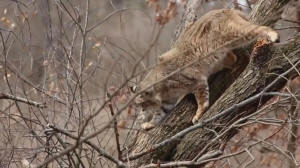Some worry bobcat hunting could put animal on endangered list in
Illinois
 Send a link to a friend
Send a link to a friend
 [March 23, 2024]
By Zeta Cross | The Center Square contributor [March 23, 2024]
By Zeta Cross | The Center Square contributor
(The Center Square) – For 40 years, bobcats were on the endangered
species list in Illinois. Bobcat hunting was illegal. That changed six
years ago when the Illinois Department of Natural Resources decided to
allow the sport hunting of bobcats for the first time in many Illinois
hunters’ memories.
Permits to hunt bobcats are wildly popular. Last year 7,000 hunters
bought $5 lottery tickets for a chance to win one of the 1,000 legal
permits to hunt bobcats.
Jennifer Kuroda, founder of the Illinois Bobcat Foundation, said the
Illinois Department of Natural Resources has not issued a comprehensive
report on the number of bobcats in the state. And they have not
published a plan for managing the bobcat population, she said.
“I’d be curious what their estimates are saying … what their surveys are
saying,” Kuroda said.
Kuroda would like data on the age and sex of the bobcats that are taken,
she said.
“Females are so important to the population and the sustainability of
the species,” she said. “I’d like to see that data.”
One unofficial estimate that was floated a few years ago is that there
were about 5,000 bobcats in the state. Meanwhile, in the past six years,
Illinois hunters have killed 1,802 bobcats. Kuroda questions how IDNR
can justify such a high bobcat kill number. The same activities that
made bobcats a threatened species 50 years ago are now being encouraged
by IDNR, she said.
“DNR is really catering to the hunting constituency, not the
conservation constituency,” Kuroda said.
The state’s digest for hunting and trapping says taking bobcats “is
prohibited in an area bounded by Interstate 39/Route 51 on the west side
and U.S. Route 36 on the south side.”

[to top of second column]
|

A bobcat
DNR.Illinois.gov

“Bobcats, like white-tailed deer, wild turkey, river otter, and beaver
made remarkable recoveries as habitat quantity and quality improved and
conservation strategies were implemented by wildlife managers,” IDNR’s
digest says. “Much of this work was funded by hunters and trappers
through license fees and the Pittman-Robertson Act, which taxes sporting
goods, firearms, and ammunition. Funds are used for wildlife
conservation including: research, habitat improvements, and acquisition
of habitat.”
Feb. 15 was the last day of the 2023-24 bobcat hunting season. Hunters
and trappers killed 370 bobcats. That’s up from 367 killed last year. Jo
Daviess County in northwestern Illinois recorded the most bobcats taken
this past season, a total of 19. Pike County is also known for bobcat
hunting.
Fifty-five percent of the bobcats taken this past season were killed by
hunters. Trappers killed 40%. Roadkill accounted for the rest.
Kuroda wonders what the point of a bobcat hunt. People don’t eat bobcat
meat. Bobcats are not a threat to children, livestock, or game birds.
Game bird numbers are declining in Illinois because of loss of habitat,
not because bobcats are killing them, Kuroda said.
Bobcats are small. An average bobcat weighs 18 to 25 pounds. They don’t
make impressive trophies. The price of a bobcat pelt is only about $40.
“Bobcats are secretive and illusive. They are probably fun to hunt,”
Kuroda said. “But it makes me angry every time I think about it.”
As a scientist, Kuroda believes that bobcats are a sign of a healthy
ecosystem. Bobcats mainly eat rodents. They help keep rodent populations
in check.
“In a healthy ecosystem, predators and prey balance things out,” she
said. |